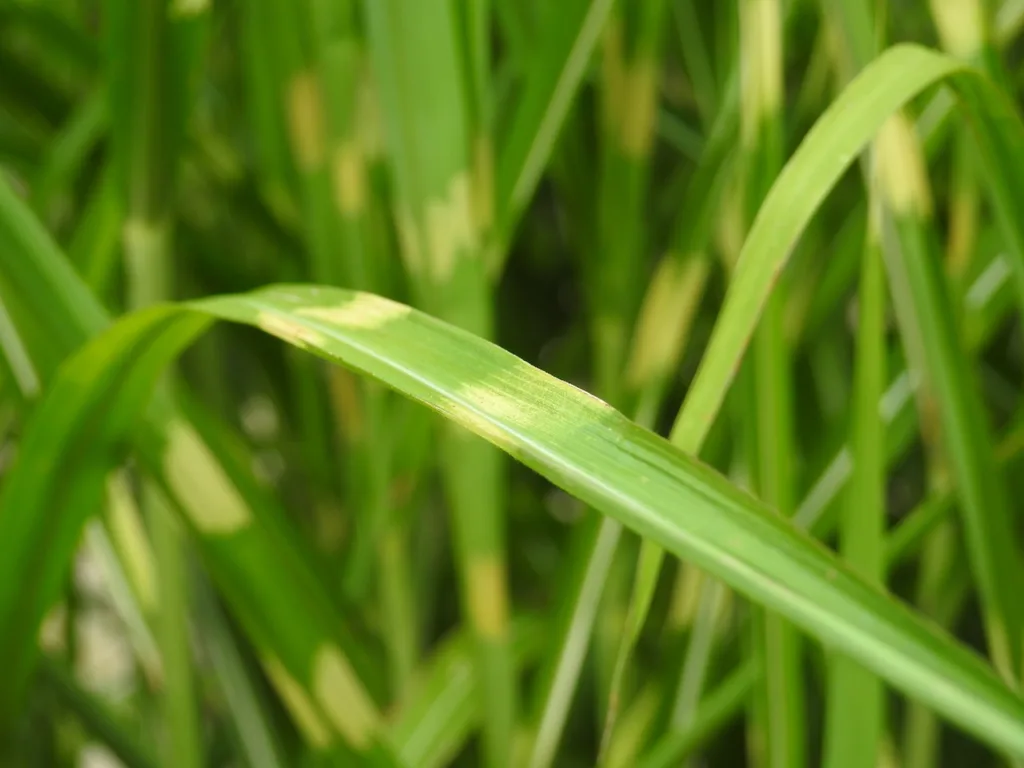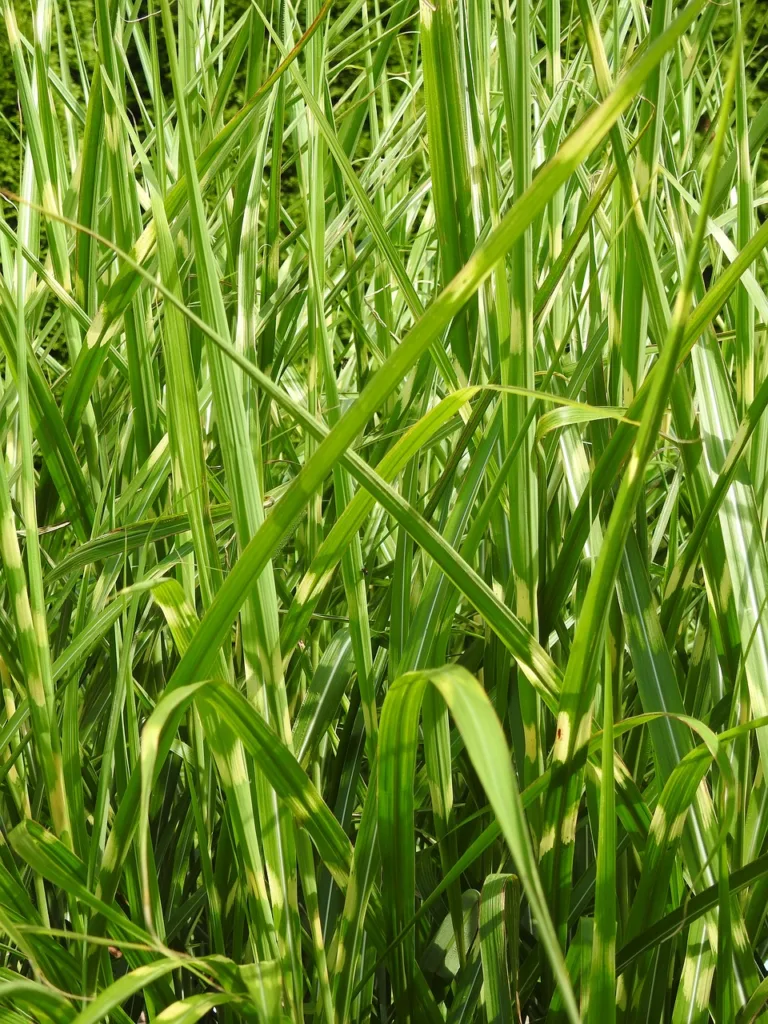If you’re looking to add an eye-catching, ornamental grass to your garden, then zebra grass is the perfect choice. Zebra Grass, scientifically known as Miscanthus sinensis ‘Zebrinus,’.
This grass variety, native to East Asia, has become a popular choice in landscaping due to its attractive appearance and adaptability.
With its long and beautiful feathers with unique stripes, zebra grass can add a touch of beauty to any landscape. Whether you’re an experienced gardener or new to gardening.
Depending on the specific variety and growing conditions, zebra grass height can reach 4 to 7 feet, making a sufficient presence in the landscape.
| Characteristic | Description |
|---|---|
| Scientific Name | Miscanthus sinensis ‘Zebrinus’ |
| Common Name | Zebra Grass |
| Family | Poaceae (Grass family) |
| Origin | East Asia (China, Japan, Korea) |
| Appearance | Tall, upright stems with horizontal yellow stripes |
| Leaf Color | Green with distinctive golden-yellow horizontal bands |
| Flower Plumes | Feathery plumes in late summer to fall |
| Height | Typically Zebra Grass height 4 to 7 feet, depending on growing conditions |
| Spread | Forms a clump with a moderate spread |
| Adaptability | Tolerant of various soil types; prefers well-drained soil |
| Sun Exposure | Full sun to partial shade |
| Landscaping Uses | Focal point, border or hedge, ornamental grass planting |
| Cultural Significance | Popular ornamental grass with striking foliage |
| Wildlife Attraction | Provides habitat and food for wildlife |
| Invasiveness | Can naturalize but is not typically considered highly invasive |
| Maintenance | Low maintenance, cut back in late winter or early spring |
| Hardiness Zone | USDA Zones 4-9 |
The Right Location for Zebra Grass
Before you start planting zebra grass, you need to find the perfect spot in your garden. This grass thrives in full sun, meaning it needs at least six hours of direct sunlight each day.
Look for an area that gets ample sunshine and has well-draining soil. Zebra grass can tolerate a wide range of soil types, but it prefers fertile soil with a slightly acidic to neutral pH level.
Pro tip: While zebra grass can tolerate drought conditions once established, it benefits from regular watering during dry spells, especially in hot climates.
Planting Zebra Grass
Now that you’ve found the ideal location, it’s time to plant your zebra grass seeds. Follow these simple steps to ensure a successful planting process:
- Dig a hole that is twice the size of the root ball of your zebra grass plant.
- Gently loosen the root ball and place the plant in the hole, ensuring that the top of the root ball is level with the surrounding soil.
- Backfill the hole with soil, firming it gently around the base of the plant.
- Water thoroughly to settle the soil and remove any air pockets.
- Apply a layer of mulch around the plant to help retain moisture and suppress weed growth.
Pro tip: If you are planting multiple zebra grass plants, make sure to space them at least four to six feet apart to allow for proper growth and airflow.
Watering and Fertilizing Zebra Grass
Zebra grass is relatively low-maintenance when it comes to watering. Once established, it is quite drought-tolerant.
However, regular watering during dry spells can help promote healthy growth. Water deeply and infrequently, allowing the top few inches of soil to dry out between waterings. Be sure not to overwater, as zebra grass is susceptible to root rot.
As for fertilizing, zebra grass doesn’t require much. A slow-release, balanced fertilizer applied in early spring should be sufficient. Avoid over-fertilizing, as this can lead to excessive foliage growth and weak stems.
Pro tip: Consider conducting a soil test to determine if any specific nutrient deficiencies need to be addressed. This will help you tailor your fertilization approach accordingly.
Pruning and Maintenance Zebra Grass
Zebra grass is a rather low-maintenance plant, but a little pruning and maintenance will help keep it looking its best. Here are some tips to help you with this process:
Spring Pruning: In early spring, before new growth emerges, trim back the dead foliage from the previous year. Cut it down to about six inches above the ground.
Division: Every three to four years, consider dividing larger clumps of zebra grass to maintain healthy growth. Dig up the clump, separate the sections, and replant them in the desired location.
Cleanup: In late winter or early spring, remove any remaining dead foliage and trim back any damaged or broken stems. This will help promote new growth and keep the plant looking tidy.
Pro tip: Use caution when pruning zebra grass, as the sharp edges of the leaves can cause cuts. Wear gloves and protective clothing to avoid any injuries.
Dealing with Common Pests and Diseases
Zebra grass is relatively resistant to pests and diseases, making it a hassle-free plant to grow. However, it’s always good to be aware of potential issues that may arise. Here are a few common pests and diseases that can affect zebra grass:
Aphids: These small, sap-sucking insects can occasionally infest the leaves of zebra grass. Use a strong blast of water to dislodge them or introduce beneficial insects like ladybugs to control their population.
Leaf Spot: This fungal disease can cause dark spots or lesions on the leaves. To prevent leaf spots, avoid overhead watering and ensure proper air circulation around the plant.
Root Rot: Overwatering or poorly drained soil can lead to root rot. To prevent this, water zebra grass correctly and plant it in well-draining soil.
Pro tip: Regularly inspect your zebra grass for any signs of pests or diseases. Early detection and prompt action can help prevent major damage.

Landscaping Uses of Zebra Grass
Focal Point: Zebra Grass serves as an excellent focal point in garden beds or borders, drawing attention with its unique foliage.
Privacy Screening: When planted in groups or rows, Zebra Grass can create effective and attractive natural screens, offering a degree of privacy in outdoor spaces.
Container Planting: Smaller cultivars of Zebra Grass are well-suited for container gardening, allowing its distinctive foliage to enhance patios or balconies.
Erosion Control: With its clumping growth habit and dense root system, Zebra Grass can be used to help prevent soil erosion on slopes.
Types of Zebra Grass
Here are a few types of Zebra Grass and related cultivars:
Miscanthus sinensis ‘Zebrinus’:
Characteristics: This is the Zebra Grass cultivar with green and gold stripes, an arching growth habit, and feathery plumes in late summer.
Miscanthus sinensis ‘Little Zebra’:
Characteristics: A smaller variety of zebra grass, ‘Little Zebra grass’ has iconic zebra-like stripes and is a great option for small gardens or containers.
Miscanthus sinensis ‘Strictus’ (Porcupine Grass):
Characteristics: Porcupine Grass, also known as Miscanthus sinensis, features upright and stiff foliage with distinctive horizontal banding. It is often used for its architectural appeal in the landscape.
Miscanthus sinensis ‘Gold Bar’:
Characteristics: ‘Gold Bar’ is a variety with broader gold bands on its leaves, creating a bold and vibrant striped pattern. It shares the arching growth habit of traditional Zebra Grass.
Miscanthus sinensis ‘Variegatus’:
Characteristics: ‘Variegatus’ is another variegated form of Miscanthus sinensis, featuring cream-colored stripes on green leaves. While not as prominent as the gold stripes in ‘Zebrinus,’ it adds a subtle variegation to the landscape.
Miscanthus sinensis ‘Gracillimus’:
Characteristics: While not explicitly zebra-striped, ‘Gracillimus’ is a popular Maiden Grass variety with narrow leaves and an elegant, arching growth habit. It is often included in discussions about ornamental grasses for its aesthetic appeal.
| It is important to keep an eye on the growth of Zebra Grass, especially in areas where the spread of invasive plant species is a concern. Some gardeners may take preventative measures, such as planting in contained areas or regularly dividing the clumps to control its spread. Before planting Zebra Grass or any other ornamental grass, it is recommended to check with your local agricultural extension offices, conservation authorities, or environmental organizations to understand specific regulations or guidelines regarding its classification and management in your region. |
How Fast Does Zebra Grass Grow
The growth rate can be influenced by various factors, including environmental conditions, soil quality, and local climate. Here are some general characteristics of the growth rate of Zebra Grass:
Establishment Period:
During the first growing season after planting, Zebra Grass concentrates on establishing its root system. As it puts energy into developing a strong foundation, growth may be slower during this period.
Subsequent Years:
In the following years, as the plant becomes established, Zebra Grass typically exhibits a faster growth rate. It can send up new shoots, and the clump gradually becomes fuller and more robust.
Height Increase:
Zebra grass can reach remarkable heights in just one growing season. The distinctive plumes that appear during late summer and fall contribute to the overall height and visual appeal of the grass.
Clump Size:
Over the years, the clump size of Zebra Grass may expand, especially if the plant is not divided regularly. This natural expansion is a characteristic feature of its growth habit.
Maintenance and Pruning:
Regular pruning and maintenance, such as cutting back the grass in late winter or early spring before new growth emerges, can help control the size and maintain the desired shape of Zebra Grass.

Conclusion
Congratulations! You are now equipped with the knowledge to successfully grow and care for zebra grass. From choosing the right location to understanding its watering and fertilizing needs, you have all the tools to create a stunning display in your garden.
Remember to prune and maintain your zebra grass regularly to keep it healthy and looking its best. Enjoy the beauty and elegance that zebra grass brings to your outdoor space!
So, get out there and let your zebra grass create a captivating focal point in your garden. With its unique striped foliage and graceful plumes, it’s sure to turn heads and make your garden the envy of the neighborhood. Happy gardening!
People Also Ask
Where does zebra grass grow best?
Zebra Grass (Miscanthus sinensis ‘Zebrinus’) grows best in well-drained soil and prefers full sun to partial shade. It is adaptable to various soil types and is hardy in USDA hardiness zones 4-9.
Is zebra grass the same as Chinese silver grass?
Zebra Grass and Chinese Silver Grass (Miscanthus sinensis) are related, but they are not the same. Zebra Grass is a specific cultivar of Chinese Silver Grass known for its distinctive horizontal yellow stripes on the green leaves.
What is the grass with a white stripe in the middle?
The grass with a white stripe in the middle is likely Zebra Grass (Miscanthus sinensis ‘Zebrinus’). It has characteristic golden-yellow horizontal stripes on its green leaves.
Is maiden grass variegated?
Maiden Grass (Miscanthus sinensis) can have variegated cultivars. One example is ‘Morning Light,’ known for its variegated foliage with white margins.
Zebra Grass for sale?
Zebra Grass (Miscanthus sinensis ‘Zebrinus’) is commonly available for purchase at nurseries, garden centers, and online plant retailers. Check local or online sources for availability.

